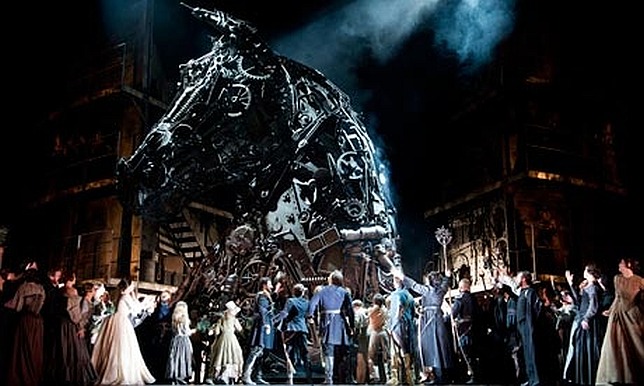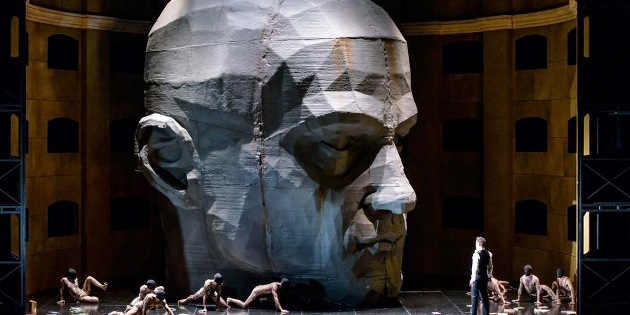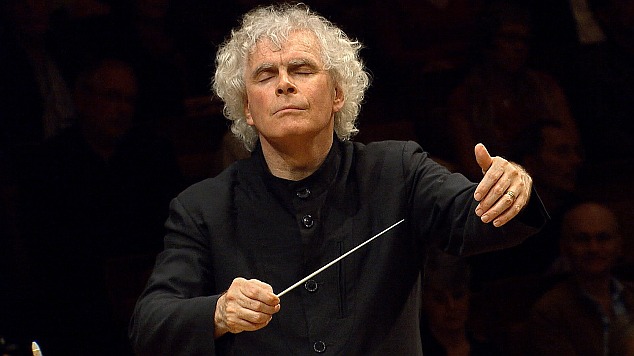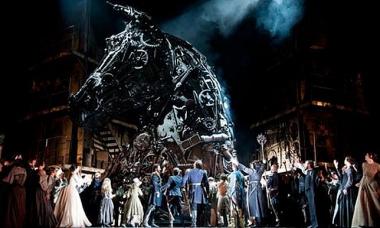How Grand Is the Grandest of Grand Opera?

"Grand opera" is generally defined as a genre originating in the 19th Century, characterized by large casts and orchestras, with lavish and spectacular design and stage effects.
San Francisco Opera announced the upcoming production of Berlioz's Les Troyens as "the biggest and heaviest physical production ever to be presented on the War Memorial Opera House stage," which made me look into specifics.
The complete two-part opera (which is coming to the War Memorial) is so big and complex that it took 32 years from Berlioz's completion of the work in 1858 to the first staged performance in 1890 (in Karlsruhe), 21 years after the composer's death. But, beyond the size and challenges of the opera itself, what about the production we'll see in the Opera House?
In addition to the chorus of 90 profiled this week in a Classical Voice article, there are 16 principals, 18 dancers and acrobats, and 10 supernumeraries – a total of 134 people onstage.
In the orchestra, there are 72 musicians, including an ophicleide and the regular 40 strings, and backstage bands with 23 musicians. The total count so far: 229, but there are more. Add costumers, makeup artists, wigmakers, ushers, guards, and – most importantly – stagehands, who are faced with sets weighing 32 tons. That weight with the addition of singers, dancers, costumes, lighting equipment, and props, meant that the Opera had to reinforce the stage. The Trojan Horse alone is 23 feet tall, constructed of steel and fiberglass.
The same production in London took almost six hours, but S.F. Opera is promising five, by reducing intermission lengths and, probably, picking up the tempo, but not at the music's expense. Various small cuts, mostly from repeated passages, amount only to eight minutes.
The plan is for acts 1 and 2 to be performed together, at 90 minutes; act 3 and 4, also combined, at 95 minutes; act 5 is 55 minutes. There will be two 30-minute intermissions (good luck getting everybody back to the seats).
If you're going to the opera thinking of Homer's "Iliad" and Virgil's "Aeneid," you'll be surprised because the costumes in this production are updated to 1855, and Troy resembles the battle of Sebastopol in the Crimean War. The Trojan soldier costumes are military uniforms from the various nations involved in the Crimean conflict. According to the Opera, "It is a strong statement on how from antiquity throughout history to modern times humanity is destined to repeat its mistakes."
Streaming Opera from Everywhere

The announcement is impressive, but the initial offering wasn't. Verdi's Traviata streamed from Madrid on Friday was somewhat of a dud, musically and theatrically. But, again, the story itself is big:
Opera Platform is a $4.5 million project, financed by the European Union's cultural budget and participating organizations, consisting of 15 European opera companies transmitting live video of performances approximately once a month over a three-year span. Each performance remains available on the web for six months.
You can use Saturday's podcast of the second work in the series, Karol Szymanowski's rarely heard King Roger from the Royal Opera, Covent Garden, to see and hear something you won't soon experience around town. While the Opera Platform website is still a bit creaky, this is a good opera-tunity. The New York Times weighed in:
Krol Roger is usually an indulgence of the kind that Sally Bowles in Cabaret would call divinely decadent. A perfumed ceremony of religion, ritual and sex, it asks for scenic spectacle, large forces and a lot of effort teaching everyone to sing in Polish - all for a running time of less than 90 minutes. … Outside Poland, where it counts as a national treasure, it’s a rare thing. So this Covent Garden staging, which runs until May 19, was a must-see."
"The Opera Platform," said the announcement, "is an online platform for the promotion and enjoyment of opera. It is designed to appeal equally to those who already love opera and to those who may be tempted to try it for the first time."
The website is being offered by the EU’s Creative Europe program in collaboration with Opera Europa, which is an association of 155 opera companies and festivals, the cultural channel Arte, and the 15 opera companies.
Future productions include Götterdämmerung from the Vienna Staatsoper, Sibelius's Kullervo from the Finnish National Opera, Arturs Maskats's Valentina from the Latvian National Opera, and Mozart's The Abduction from the Seraglio from the Aix-en-Provence festival in France.
Jobin Named to Lead Toledo Opera and Symphony
Jobin created a precedent in San Francisco, leading mainstage productions, including Tosca and The Flying Dutchman — the first woman conductor in the company's then 81-year-long history.
Jobin also led all performances of the San Francisco Opera world premiere of Rachel Portman’s 2007 The Little Prince, the S.F. Opera-commissioned The Secret Garden by Nolan Gasser in 2013, and one performance of the S.F. Opera's world premiere production of Philip Glass' Appomattox in 2008.
A Bernstein Scholar, Jobin graduated from Harvard University with a degree in music, and wrote her senior thesis about five women conductors, "studying what my life would be like if I chose this as a profession." By now, however, she is not focusing on that aspect of her career. "The musicians don’t care if I’m male or female, green or purple, or from Mars or Jupiter," she told the Toledo Blade. "I love the music. I serve the music."
In San Francisco, she was assistant to Donald Runnicles, then the Opera's music director, and led several Merola opera performances to critical acclaim, going on to a conducting career on the East Coast, heading the Center for Contemporary Opera in New York, and in Europe.
Simon Rattle Cannot Be Replaced – At Least Not Yet

The Berlin Philharmonic, which has been selecting its music director since musicians formed the orchestra in 1882, has failed to find a successor to Simon Rattle, named to the post in 2002 and planning to leave at the end of his contract in 2018.
Last week, the 123 voting members of the orchestra deliberated for 11 hours, and were unable to reach a majority vote, or if they extended an invitation, it was turned down. A spokesman reported "lively" discussions, and said a decision would likely be reached within one year.
Since Herbert von Karajan became music director in 1954, there have been only two other music directors: Claudio Abbado and Rattle.
Although the Philharmonic, where former San Francisco General Director Pamela Rosenberg was general manager from 2006 to 2010, is one of the world's leading orchestras, salaries are somewhat below those of major American organizations. The base salary is uniformly $117,000 annually for all players; principals receive an additional 15 percent. Hiring new musicians is by an audition committee with one vote for each member, including the music director (who has no power to fire anyone).

